TC
Auto Added by WPeMatico
Auto Added by WPeMatico
Cytera CellWorks hopes to revolutionize the so-called “clean meat” industry through the automation of cell cultures — and that could mean one day, if all goes to plan, the company’s products could be in every grocery store in America.
Cytera is a ways off from that happening, though. Founded in 2017 by two college students in the U.K., Ignacio Willats and Ali Afshar, Cytera uses robotic automation to configure cell cultures used in things like growing turkey meat from a petri dish or testing stem cells.
The two founders — Willats, the events and startups guy and Afshar the scientist, like to do things differently to better configure the lab, as well — like strapping GoPros to lab workers’ heads, for instance. The two came together at the Imperial College of London to run an event for automation in the lab and from there formed their friendship and their company.
“At the time, lab automation felt suboptimal,” Afshar told TechCrunch, further explaining he wanted to do something with a higher impact.
Cellular agriculture, or growing animal cells in a lab, seems to hit that button and the two are currently enrolled in Y Combinator’s Summer 2018 cohort to help them get to the next step.
There’s been an explosion in the lab-made meat industry, which relies on taking a biopsy of animal cells and then growing them in a lab to make the meat versus getting it from an actual living, breathing animal. In just the last couple of years startups like Memphis Meats have started to pop up, offering lab meat to restaurants. Even the company known for its vegan mayo products, Hampton Creek (now called Just), is creating a lab-grown foie gras.
Originally, the company was going to go for general automation in the lab, but had enough interest from clients and potential business in just the cell culture automation aspect they changed the name for clarity. Cytera already has some promising prospects, too, including a leading gene therapy company the two couldn’t name just yet.
Of course, automation in the lab is nothing new and big pharma has already poured billions into it for drug discovery. One could imagine a giant pharma company teaming up with a meat company looking to get into the lab-made meat industry and doing something similar, but so far Willats and Afshar says they haven’t really seen that happening. They say bigger companies are much more likely to partner with smaller startups like theirs to get the job done.
Obviously, there are trade-offs at either end. But, should Cytera make it, you may find yourself eating a chicken breast one day built by a company who bought the cells made in the Cytera lab.
Powered by WPeMatico
HQ Trivia’s app store ranking has continued to sink the past three months, but it’s hoping a new version on your television could revitalize growth. HQ today launched an Apple TV app that lets users play the twice-daily live quiz game alongside iOS Android players. “Everything about the game is still the same – same questions, same time, same rules,” says a spokesperson, except you’ll play with the Apple TV remote instead of your phone’s screen. But that might not be enough to get HQ’s player count rapidly growing again.
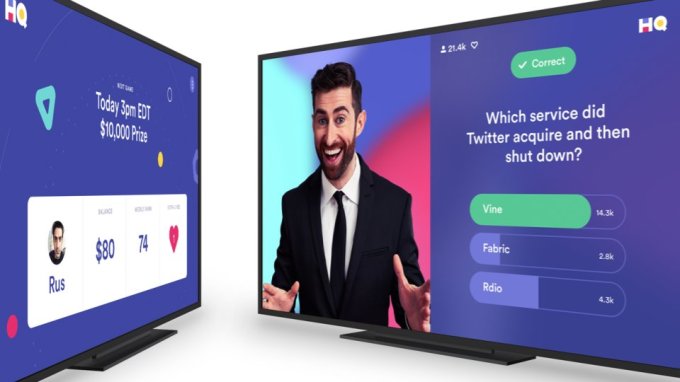
According to App Annie’s app store ranking history, on iOS HQ has fallen from the No. 1 U.S. trivia game to No. 10, from the No. 44 game to No. 196, and from the No. 151 overall app to No. 585. It’s exhibited a similar decline on Android. Analytics firm Sensor Tower estimates HQ has seen 12.5 million lifetime installs by unique users, with about 68 percent on iOS. “Installs have been on the decline. For last month, we estimate them with about 560K, which is down from their height of more than two million per month back in February,” Sensor Tower’s head of mobile insights Randy Nelson tells TechCrunch.
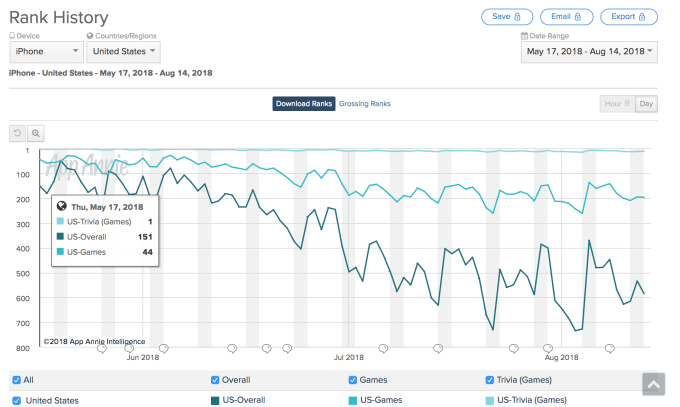
The question is whether this is just a summer lull as people spend time outside and students aren’t locked in the schedule of school, or if HQ is in a downward spiral beyond seasonal fluctuations. But if we zoom out, you can see that HQ has been dropping down the charts through the school year since peaking in January. At one point it climbed as high as the No. 3 game and No. 6 overall app. The app’s record high of concurrent players has also declined from a peak of 2.38 million in late March.
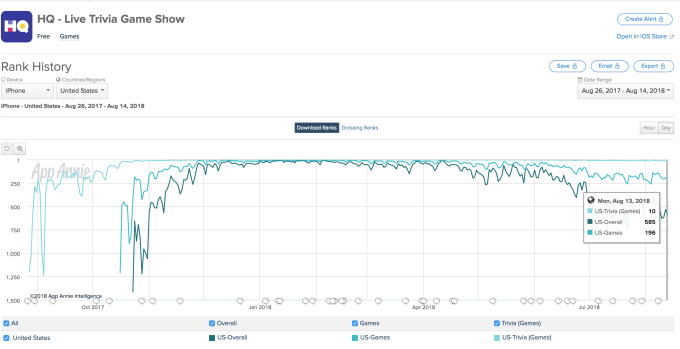
[Update: The CEO of HQ Trivia parent company Intermedia Labs and the former co-founder of Vine, Rus Yusupov, weighed in on the decline in downloads and HQ’s plans. He says, “Games are a hits business and don’t grow exponentially forever,” signalling the drop-off was expected and the team is still optimistic. But he also notes that HQ is “developing new game formats, one of which we think is really special and complements Trivia nicely”, indicating that HQ will branch out beyond its 12-question everyone vs everyone approach.]
Games are a hits business and don’t grow exponentially forever. HQ has massive early traction and still millions playing daily. Also developing new game formats, one of which we think is really special and complements Trivia nicely. More soon! Until then thanks for playing
https://t.co/wnAcztBuJU
— Rus (@rus) August 14, 2018
Meanwhile, new clones keep popping up. After the initial wave of Chinese live trivia apps, now U.S. television studios are getting into the mix. This week Fox unveiled FN Genius, which looks and works almost exactly the same as HQ. One of HQ’s long-time rivals, Trivia Crack, where users play asynchronously over the course of days, also declined earlier this year, but has bucked HQ’s trend and started rising on the App Store charts again. There are also new 1-on-1 trivia games like ProveIt that let players bet real money on whether they can outsmart their opponent.
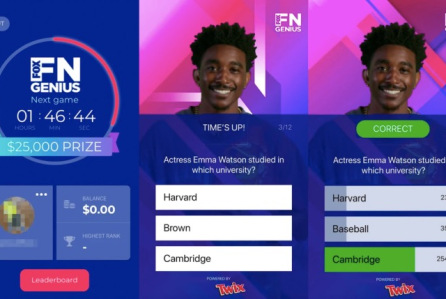
Fox’s FN Genius. Image via Deadline
With themed games, celebrity hosts, big jackpots like a recent $400,000 prize and new features like the ability to see friends’ answers, HQ has tried to keep its app novel. But it’s also encountered cheaters and people playing with multiple phones that make normal players feel like they’ll never win. While the live aspect adds urgency, it also can feel interruptive with time as users aren’t always available for its noon and 6pm Pacific games. HQ may need to launch a second game app, come up with some new viral hooks or find ways to revive lapsed players if it’s going to make good on the $15 million its parent company raised in March.
Powered by WPeMatico
Don’t want to get pregnant? There’s a Food and Drug Administration approved app for that. The FDA has just given the go ahead for Swedish app Natural Cycles to market itself as a form of birth control in the U.S.
Natural Cycles was already in use as a way to prevent pregnancy in certain European countries. However, this is the first time a so-called ‘digital contraceptive’ has been approved in America.
The app works using an algorithm based on data given by women using the app such as daily body temperature and monthly menstrual cycles. It then calculates the exact window of days each month a woman is most fertile and therefore likely to conceive. Women can then see which days the app recommends they should avoid having sex or use protection to avoid getting pregnant.
Tracking your cycle to determine a fertile window has long been used to either become pregnant or avoid conceiving. But Natural Cycles put a scientific spin on it by evaluating over 15,000 women to determine its algorithm had an effectiveness rate with a margin of error of 1.8 percent for “perfect use” and a 6 percent failure rate for “typical use.”
What that means is almost two in every 100 women could likely conceive on a different date than the calculated fertile window. That’s not exactly fool-proof but it is higher than many other contraceptive methods. A condom, for instance, has an 18 percent margin of error rate, according to the Centers for Disease Control (CDC).
And though the app makers were able to convince the FDA of its effectiveness, at least one hospital in Stockholm has opened an investigation with Sweden’s Medical Products Agency (MPA) after it recorded 37 unwanted pregnancies among women who said they had been using the app as their contraception method.
“Consumers are increasingly using digital health technologies to inform their everyday health decisions, and this new app can provide an effective method of contraception if it’s used carefully and correctly,” assistant director for the health of women in the FDA’s Center for Devices and Radiological Health Terri Cornelison said in a statement.
However, she also acknowledged there was a margin of error in the app’s algorithm and other contraceptive methods. “Women should know that no form of contraception works perfectly, so an unplanned pregnancy could still result from correct usage of this device,” she said.
Powered by WPeMatico
Zombie-like passive consumption of static video is both unhealthy for viewers and undifferentiated for the tech giants that power it. That’s set Facebook on a mission to make video interactive, full of conversation with broadcasters and fellow viewers. It’s racing against Twitch, YouTube, Twitter and Snapchat to become where people watch together and don’t feel like asocial slugs afterward.
That’s why Facebook today told TechCrunch that it’s acqui-hired Vidpresso, buying its seven-person team and its technology but not the company itself. The six-year-old Utah startup works with TV broadcasters and content publishers to make their online videos more interactive with on-screen social media polling and comments, graphics and live broadcasting integrated with Facebook, YouTube, Periscope and more. The goal appears to be to equip independent social media creators with the same tools these traditional outlets use so they can make authentic but polished video for the Facebook platform.

Financial terms of the deal weren’t disclosed, but it wouldn’t have taken a huge price for the deal to be a success for the startup. Vidpresso had only raised a $120,00 in seed capital from Y Combinator in 2014, plus some angel funding. By 2016, it was telling hiring prospects that it was profitable, but also that, “We will not be selling the company unless some insane whatsapp like thing happened. We’re building a forever biz, not a flip.” So either Vidpresso lowered its bar for an exit or Facebook made coming aboard worth its while.
For now, Vidpresso clients and partners like KTXL, Univision, BuzzFeed, Turner Sports, Nasdaq, TED, NBC and others will continue to be able to use its services. A Facebook spokesperson confirmed that customers will work with the Vidpresso team at Facebook, who are joining its offices in Menlo Park, London and LA. That means Facebook is at least temporarily becoming a provider of enterprise video services. But Facebook confirms it won’t charge Vidpresso clients, so they’ll be getting its services for free from now on. Whether Facebook eventually turns away old clients or stops integrating with competing video platforms like Twitch and YouTube remains to be seen. For now, it’s giving Vidpresso a much more dignified end than the sudden shutdowns some tech giants impose on their acquisitions.
“We’ve had a lot of false starts along the way . . . We finally landed on helping create high quality broadcasts back on social media, but we still haven’t realized the full vision yet. That’s why we’re joining Facebook,” the Vidpresso team writes. “This gives us the best opportunity to accelerate our vision and offer a simple way for creators, publishers, and broadcasters to use social media in live video at a high quality level . . . By joining Facebook, we’ll be able to offer our tools to a much broader audience than just our A-list publishing partners. Eventually, it’ll allow us to put these tools in the hands of creators, so they can focus on their content, and have it look great, without spending lots of time or money to do so.”
Facebook Live has seen 3.5 billion broadcasts to date, and they get six times as many interactions as traditional videos. But beyond public figures, game streamers, and the odd moment of citizen journalism, it’s become clear that most users don’t have compelling enough content to stream. Interactivity could take some pressure off the broadcaster by letting the audience chip in.
Facebook already has some interactive video experiments out in the wild. For users, it recently rolled out its Watch Party tool for letting Groups view and chat about videos together. It’s also trying new games like Lip Sync Live and a Talent Show feature where users submit videos of them singing. For creators, Facebook now let streamers earn tips with its new Stars virtual currency, and lets fans subscribe to donating money to their favorite video makers like on Patreon. And on the publisher side, Facebook Live has also built tools to help publishers pull in social media content. It’s even got an interactive video API that it’s developing to allow developers to launch their own HQ Trivia-game shows.
But the last line of Vidpresso’s announcement above explains Facebook’s intentions here, and also why it didn’t just try to build the tools itself. It doesn’t just want established news publishers and TV studios making video for its platform. It wants semi-pro creators to be able to broadcast snazzy videos with graphics, comments and polls that can aesthetically compete with “big video” but that feel more natural. This focus on creators over news outlets aligns with reports of Facebooks head of journalist relations Campbell Brown allegedly saying that Mark Zuckerberg doesn’t care about publishers and that “We are not interested in talking to you about your traffic and referrals any more. That is the old world and there is no going back.” Facebook has contested these reports.
Every internet platform is wising up to the fact that web-native creators who grew up on their sites often create the most compelling content and the most fervent fan bases. Whichever video hub offers the best audience growth, creative expression tools and monetization options will become the preferred destination for creators’ work, and their audiences will follow. Vidpresso could help these creators look more like TV anchors than selfie monologuers, but also help them earn money by integrating brand graphics and tie-ins. Facebook couldn’t risk another tech giant buying up Vidpresso and gaining an edge, or wasting time trying to build interactive video technology and expertise from scratch.
Powered by WPeMatico
Microsoft announced today that it’s released Azure Stack for Azure Government at a time when it’s battling rivals at Amazon and other cloud companies for the massive winner-take-all $10 billion Pentagon cloud contract known as JEDI.
Azure Stack provides customers with a similar set of cloud services that they would get in the public cloud, but inside the cozy confines of the customer data center. For Azure cloud customers who are looking to manage across public and private environments, often referred to as a hybrid approach, it gives a common look and feel across both public and private.
“As a cornerstone of Microsoft’s hybrid cloud approach, consistency means government customers get the same infrastructure and services with Azure Stack as they do with Azure — the same APIs, DevOps tools, portal, and more,”Natalia Mackevicius, Program Director, Microsoft Azure Stack wrote in a blog post announcing the new program.
In addition, the company announced it had passed a third-party FedRamp certification. FedRamp is a government program that provides a standardized way for government procurement officials to assess cloud security.
“Azure Stack for Azure Government directly addresses many other significant challenges our top federal government customers face. This includes tough regulatory, connectivity and latency requirements,” Mackevicius, wrote in a blog post announcement.
While this product is geared for any government customer, this news could certainly be appealing to the Pentagon, which is looking for one vendor to rule them in its latest mega cloud RFP. While Microsoft wouldn’t comment on JEDI specifically because it’s in the midst of answering that RFP, the timing can’t be a coincidence.
Microsoft, along with other competitors including Oracle and IBM, have been complaining bitterly that the one-vendor contract process unfairly favors Amazon. These companies have recommended that the Pentagon go with a multi-vendor approach to prevent lock-in and take advantage of innovation across sellers. The complaints so far has fallen on deaf ears at the Pentagon.
Regardless, Microsoft is still battling hard for the massive contract and today’s release certainly bolsters their approach as they continue to fight to win the JEDI deal — and other government business.
Powered by WPeMatico
There is a secret behind every open office in Silicon Valley — and it isn’t the drain on productivity.
Tech companies have been the vanguards for pushing corporate culture forward toward “radical transparency.” Mark Zuckerberg works in a fully transparent four-walled glass office surrounded by the rest of Facebook. Valve got rid of managers and titles so everyone can be their own boss. Startup founders host weekly town halls, Friday all-hands, and AMAs. Companies go to painstaking lengths to signal that they trust their employees – to show that this is your company.
But while your company might adopt an open floor plan and give out free snacks so you can feel closer to your coworkers, they likely don’t want you knowing how much they make, who is affected by the impending layoffs, or whether executives are making the right decisions.
The open office has never been more closed, and tech companies are no different than old corporate America in their authoritarian approach to controlling how their employees should think about issues that matter in the workplace. In fact, it may even be more insidious because it’s tucked away behind the veneer of a cheerful, open office.
This is what makes social network Blind so fascinating. Raw and unfiltered, Blind is the antithesis to HR’s utopic vision of a manageable and orderly corporate culture. Instead, it operates outside the walled gardens of IT with no rules and no official corporate supervision.
With Blind, users are completely anonymous, but are required to submit a verified work email to join a company channel. Inside, they are able to freely ask, discuss, prod, and complain without fear of retribution or judgment.
In short, it’s HR’s worst nightmare, and it’s wildly successful.
Blind’s engagement numbers are staggering. It has over 2 million users, including 43K at Microsoft, 28K at Amazon, and 10K at Google. In South Korea, half of all employees at companies over 200 people are active monthly. The typical monthly active user logs in three to four times per day and spends 35 minutes using the app. At the height of the Susan Fowler scandal, Uber employees were spending almost 3 hours a day on Blind. All that, and the entire company is 38 people.
At the heart of Blind’s magic is something universal to every person who has ever been employed — the duality between our personal selves and our “work” selves, and the human drive to be both intimate and in control of our relationships. There is no place more difficult to navigate this duality than the workplace, where we want to feel loved and understood, but also respected.
Hierarchy, politics, and negative career impacts burden conversations about difficult topics, and so Blind tears these barriers down one employee at a time, affording a space for uninhibited dialogue. More importantly, Blind succeeds as a resource for questions not only company-related, but also around career, family, and life decisions.
Blind is in many ways an evolution of a long lineage of ideas in social networking. It’s unique achievement is the recombination of these different ideas to create a platform that is both a safe space for free and open conversation (via anonymity), along with a vetted, contextually relevant community (via workplace email authentication).
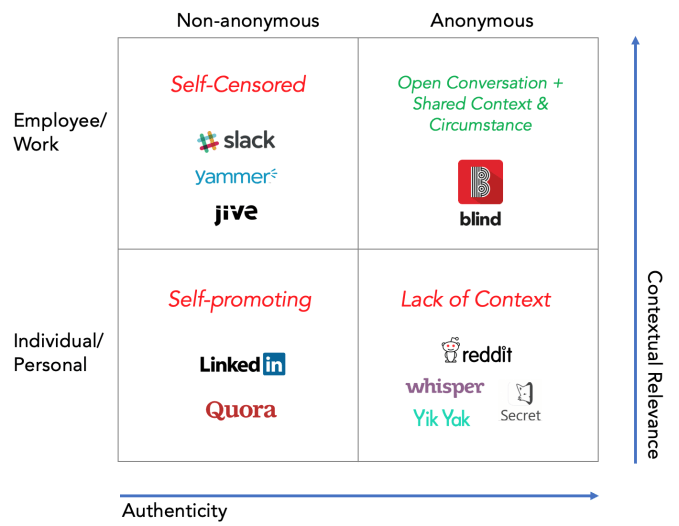
Let’s walk though each of these categories to understand Blind’s success.
Lack of Context (Anonymous + Individual/Personal) – Companies like Yik Yak, Secret, and Whisper pioneered the anonymous social network on the consumer side. However, they were beleaguered by cyberbullying, and served more as a digital exhaust pipe for teenage angst and trolling. Perhaps the most successful semi-anonymous social network today is Reddit, where legions of loyal community members cover every topic imaginable. However, what all of these anonymous communities lack is the critical element of shared context and circumstance.
Put another way, your fellow community members on Reddit may share your interest in ice fishing, but they likely will not understand who you are. As Blind cofounder Kyum Kim puts it, “it’s hard for someone to complain on Reddit about feeling poor while making $200K a year without fear of backlash, but on Blind, your coworkers are in the same income bracket, and likely similar education levels, neighborhoods, etc. They can empathize with your situation.” On Blind, there is a single community (your workplace) that spans multiple topics, and there’s a baseline, tacit understanding of each other’s life circumstances, allowing for deeper conversations.
Self-Promoting (Non-Anonymous + Individual/Personal) – LinkedIn and Quora are useful professional platforms, but because individuals and brands are the stars of these platforms, posturing and self-promotion can be quite frequent. When you ask a question on Quora, you are submitting your inquiry to a body of self-proclaimed experts. While many responses can be genuine, the ultimate currency that drives the platform is credibility and brand building, which inhibit authentic and vulnerable conversations from occurring.
Self-Censored (Non-Anonymous + Employee/Work) – On the enterprise side, Yammer, Jive, and recently Slack have attempted to upgrade the creaky company intranet into the enterprise social network. While these tools might make it easier to connect to your coworkers, the conversations happening on these platforms are no different than before – ultimately, these tools are designed to get work done, not for questioning, debating, or reflecting on how work should be. Conversations about sensitive subjects (e.g. how to deal with a bad manager) are unlikely to happen on a non-anonymous, corporate-sanctioned platform where that same bad manager might well be watching.
Finally, we have Blind. The platform strikes a balance between the freedom of anonymity and the context of a shared workplace. The result is a forum for surprisingly rich, relevant, and authentic conversations. While company channels are accessible only to insiders, a look at Blind’s public site (where you still need a verified work email, but you can chat with anyone outside your company) reveals a flavor for the types of conversations that are possible. An engineer at Amazon recently posted about how to deal with a mid-life crisis, with 42 responses of encouragement and advice. Another employee moving from India has a wife suffering from depression and is seeking help navigating the US healthcare system.
It turns out that where we work is a good proxy for who we are, and our coworkers have been an untapped community of wisdom.

Catalin205 via Getty Images
Blind is by no means perfect. Like all online platforms and particularly anonymous ones, it invites its share of trolls. One look at the “Relationships” section on Blind’s public site and you’ll find questions about how to deal with one-night stands with coworkers and a poll asking guys how many girls they’ve slept with before marriage. While these questions could certainly have come from a genuine place, they are easy fodder for trolls, and the ensuing conversations can be alienating and provide an unnecessary megaphone for toxic bro culture.
Blind acknowledges that these issues exist, but claim that they happen less frequently inside company channels. Because users authenticate with their work emails, cofounders Sunguk and Kim believe that Blind users feel a greater sense of responsibility to each other because they are engaging a real community with shared context and goals.
The vast terrain of cyberspace might suffer from the tragedy of the commons and moral hazard, but within your workplace channel on Blind, your digital community maps onto a physical community – even though you are anonymous. This is evidenced by the successful self-policing on the platform, where 0.5% of all posts have been removed (higher than average for a social media platform), and all of these originated from user-generated flags.
Blind’s success illuminates a reality that is often overlooked: corporations aren’t naturally democratic or transparent. While there are platforms to discuss our roles as individual working professionals (e.g. LinkedIn), there are very few places to gather and organize as employees of companies to collectively bargain for a better workplace.
This is by design. HR, the supposed watchdog of employee wellness, is neither elected nor truly representative, as they must balance the competing goals of being a third party resource for employees while also protecting the company against its employees.
Companies will always be incentivized to maintain an asymmetry of information. Friday all-hands and town halls are heavily scripted by companies. Rarely do we see anyone describing a healthy, transparent culture as a place where employees are freely conversing amongst themselves.
For companies with something to hide, the idea of a public square where conversations happen freely should be alarming. Blind has already been at the center of exposing two major scandals (e.g. the “nut rage” incident by a Korean Air executive and the news that Lyft was spying on its users.)
Blind picks up where labor unions left off and where HR has failed — to serve as a safeguard against corporate overreach, and to provide a protected space for employees to collaborate around solutions to improve the workplace.
For companies, Blind’s rise shouldn’t be seen as bad news. Blind can be a rich source of insight where HR software falls short. While employee engagement surveys have become popular in HR circles (and a crop of well-funded HR tech companies have consequently flooded the market), these practices suffer from the same issues of hosting a town hall. The company decides on the questions asked and interprets the answers given. With Blind, for the first time, HR and executives will have a pulse on employee sentiment that is both real-time and authentic. As Moon puts it, “no company is perfect, and if it was, Blind would not need to exist.”
In short, Blind understands more about your employees than anything in your HR stack.
Where does Blind go from here? Moon and Kyum believe they’re just getting started. Today, Blind is only available in the U.S. and South Korea, and it has been focused on tech companies. Their push into more traditional industries is showing some early signs of success with Johnson & Johnson, Dow Chemical, Barclays, and the US Navy coming online recently. There is still work to do in cleaning up different communities to ensure that conversations are inclusive and not alienating. And of course, Blind has to find a path to becoming a sustainable, revenue-generating company without compromising its integrity with users.
But one can only imagine the potential for Blind if it continues on its path upwards — the anonymous social network that understands who you are, the pulse survey that is authentic and real-time, and the first truly safe and open office made for employees, by employees.
Powered by WPeMatico
The launch of Fortnite Battle Royale has left Google in a slight predicament. While Google is in no way hard up for cash, Fortnite Battle Royale for Android certainly represented the potential for a relatively big revenue stream for an app. That is, until Epic Games decided it would launch Fortnite for Android from its own website, circumventing the Play Store.
But revenue aside, there’s also the matter of Google probably not liking the idea of huge titles circumventing the Play Store as a precedent. Plus, the lack of Fortnite Battle Royale within the Play Store poses a slight security risk to users, as there are quite a few V-bucks scams and malicious clones looking to capitalize on the popularity of Fortnite.
That’s why the Google Play store now displays a message to users in response to searches for “Fortnite,” “Fortnite Battle Royale” and other similar search queries.
“Fortnite Battle Royal by Epic Games, Inc is not available on Google Play,” reads the message.
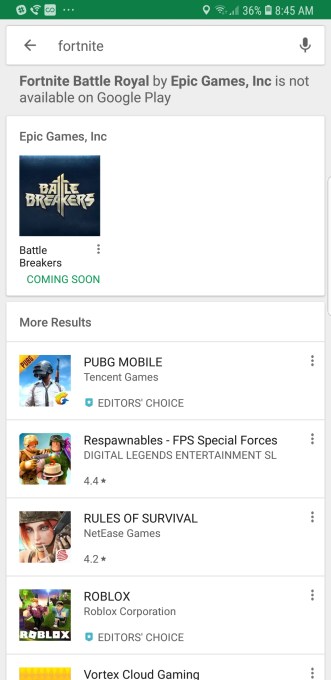 That’s right. Google misspelled the “Royale” in Battle Royale. It was likely an honest mistake, but given the fact that Epic Games is making upwards of $300 million in revenue a month, which Google is not getting a cut of, it makes for some fun back-and-forth for us spectators.
That’s right. Google misspelled the “Royale” in Battle Royale. It was likely an honest mistake, but given the fact that Epic Games is making upwards of $300 million in revenue a month, which Google is not getting a cut of, it makes for some fun back-and-forth for us spectators.
Google lists PUBG Mobile, Fortnite’s biggest competitor, at the top of all Fortnite Battle Royale queries, but doesn’t include anything in its message around how to actually find the real Fortnite Battle Royale for Android .
While Google Play’s app review process should catch the vast majority of malicious clones, the message is at least moderately helpful for folks hearing about the Android version of Battle Royale without knowing the details around Epic’s launcher.
For what it’s worth, Fortnite for Android isn’t yet available to everyone. The game launched yesterday as a Samsung exclusive for folks with a Galaxy S 7 or higher, and will become available to all Android phone owners on August 12.
[via 9to5Google]
Powered by WPeMatico
Adam Pittenger knows that moving is tough — after all, he said he’s moved eight times in the past seven years.
Pittenger said that there are several reasons why the process can be stressful, like the fact that most people aren’t experts on moving, since they don’t do it as often as him (seriously, eight times is crazy). Plus, there’s just an enormous amount of planning and coordination required, whether it’s hiring movers, buying packing materials or putting your things into storage.
So Pittenger decided to make the whole process a lot easier by founding Moved. Moving, he said, “doesn’t have to be that stressful,” because with Moved, you get “a personal assistant coordinating all the aspects of your move.”
Moved is announcing that it’s raised $3.2 million in seed funding from Lowe’s Ventures (the early-stage investment arm of the home improvement giant), FJ Labs, AngelPad, Real Estate Technology Ventures and others.
To sign up for Moved, you fill out a questionnaire about where you’re moving to and from, and what kinds of services you need. Moved (available via desktop web or mobile app) will then reach out to movers and provide you with multiple quotes from which you can choose.
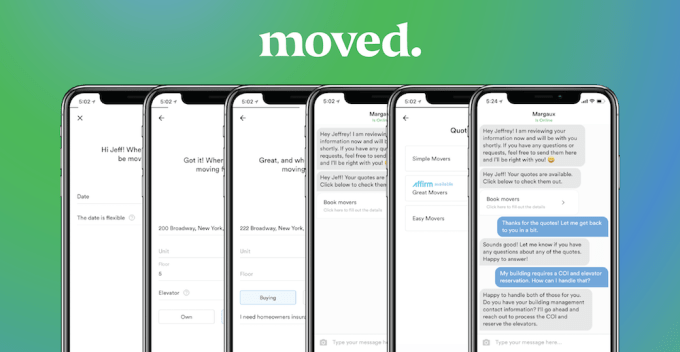
And while, as Pittenger put it, “the immediate thing you need to do is book the movers,” Moved offers a broader range of services, like ordering packing supplies, helping you donate stuff you don’t need anymore, finding a storage unit, updating your address, finding painters and more.
Moving can also be expensive, so the company has announced a partnership with Affirm, where Affirm’s financing will allow you to break up the moving costs into monthly payments.
To be clear, Moved isn’t doing the moving itself — instead, it’s basically connecting you to a marketplace of movers and other service providers. Pittenger said the company is “very strict about the suppliers and the vendors” and will remove them if customers aren’t happy with their experience.
Moved is managing all of this through a real, human assistant who can help you figure out what you need, handle the scheduling and serve as a “consumer advocate” who ensures that you’re not getting ripped off.
Pittenger said the service is free for consumers, with a fee charged to vendors at the time of booking. And it’s available throughout the United States.
Powered by WPeMatico
Samsung introduced a wide range of gadgets and upgrades today at its Unpacked event in Brooklyn. The overarching theme of the event centered on increased productivity throughout its connected ecosystem with performance improvements across the board.
Here are seven takeaways from Samsung Unpacked:
1. Note 9 rumors are confirmed
Samsung’s latest phablet was introduced this afternoon without much surprise after weeks of leaks, speculation and even a photo of CEO DJ Koh using the phone in public made their rounds online. Little has changed aesthetically on this year’s Note, aside from a few new colors, a shifted fingerprint scanner and a screen that’s a fraction of an inch larger than its predecessor. The one improvement that does stand out, however, is found in the Note’s battery, which now measures 4,000mAh hours — that’s a 700mAh jump over the Note 8. Samsung is on the offensive this time around and made sure to highlight its eight-point safety check the company instituted after the firestorm of Note 7 batteries exploding.
2. Increased functionality on the S-Pen

Samsung’s stylus got its own reboot today with a focus on performance. The company has equipped the S-Pen with Bluetooth low energy, allowing users to untether themselves from the phone and use the stylus as a remote to take pictures, advance slideshows or play music. Samsung also said developers will be able to incorporate BLE into their apps later this year.
3. The new Galaxy Watch seeks mainstream adoption
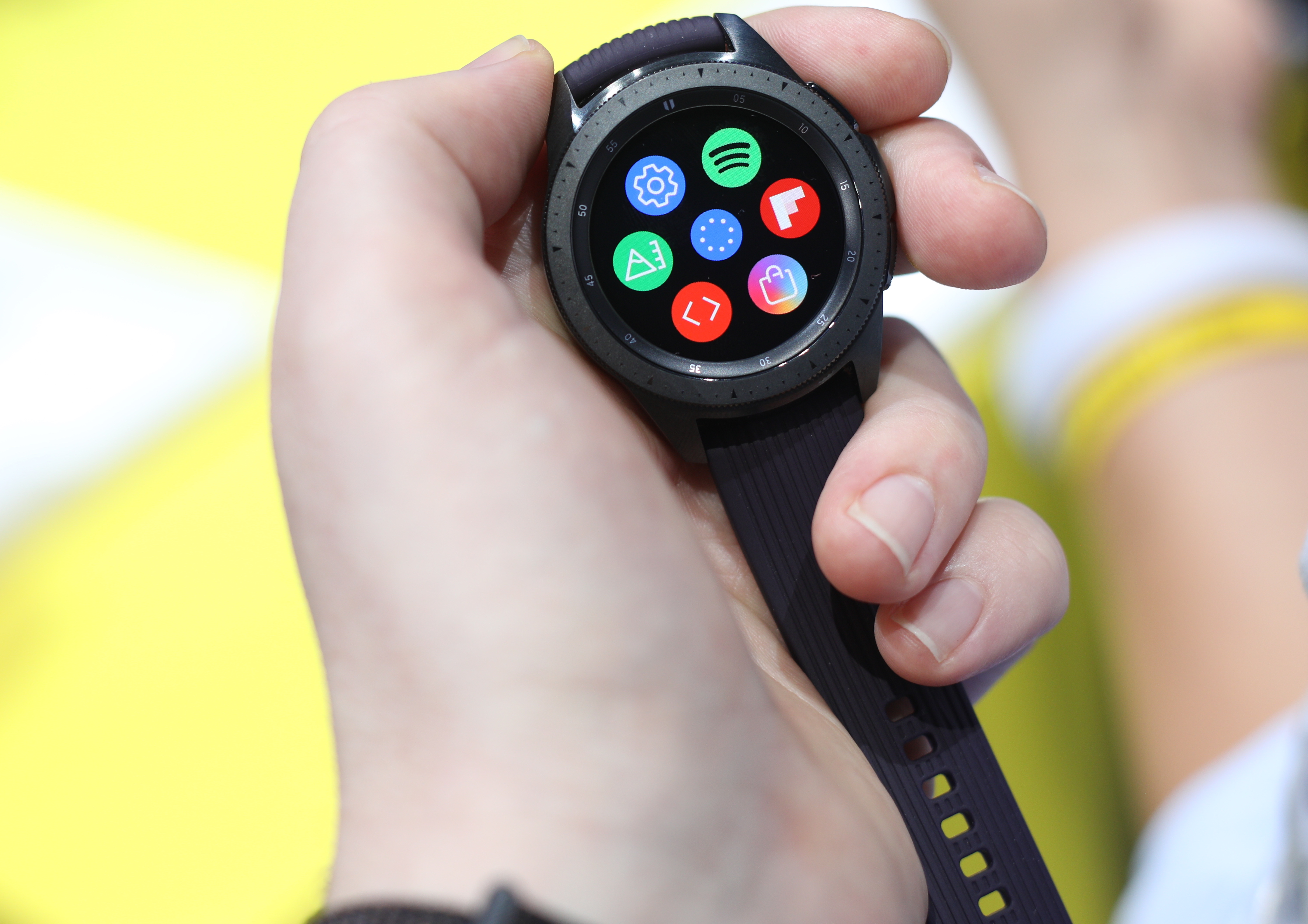
While Note 9 rumors were swirling leading up to today’s event, Samsung did a better job at keeping its new Galaxy Watch under wraps. The company’s latest smartwatch will come in two sizes, an improvement from previous Samsung watches that were too large for many wrists. Samsung beat Apple to the draw by introducing LTE functionality on the Galaxy Watch and it’s sticking with Tizen as an OS, rather than switching to Android Wear.
4. Bixby gets more conversational
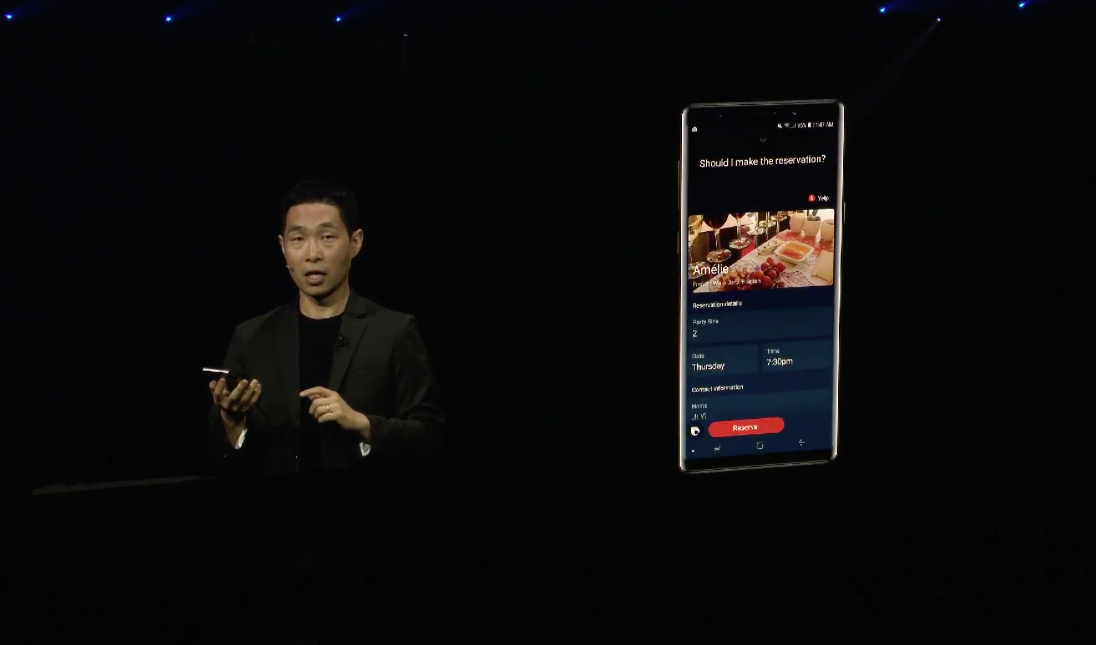
Samsung demoed an updated version of Bixby, the company’s voice assistant that saw much backlash when it was released last year, due to its lackluster performance. Luckily, that’s changed, and at today’s event Samsung showed how Bixby will carry on conversations and answer follow-up questions. The upgrade also features a range of app integrations with Yelp, Uber, Ticketmaster and more, allowing users to make reservations, hail rides and buy tickets even if they don’t have the app installed on their phone. Samsung also noted that Bixby will learn from your past decisions to better serve requests in the future. For example, if you’ve asked for French restaurants in the past, Bixby will generate other French restaurants in future requests related to food.
5. Samsung is (finally) getting into the smart speaker game

Improvements to Bixby were made even more apparent when Samsung unveiled its own smart speaker at today’s event. The Galaxy Home features a cloth covering and a tripod stand with a built-in subwoofer and eight microphones designed for far-field communication that’s seen on other smart speakers. Much like the initial announcement of the HomePod, there wasn’t much information on a release date or price. For now, the product is only listed as “coming soon.”
6. Spotify integration allows for seamless cross-listening experience
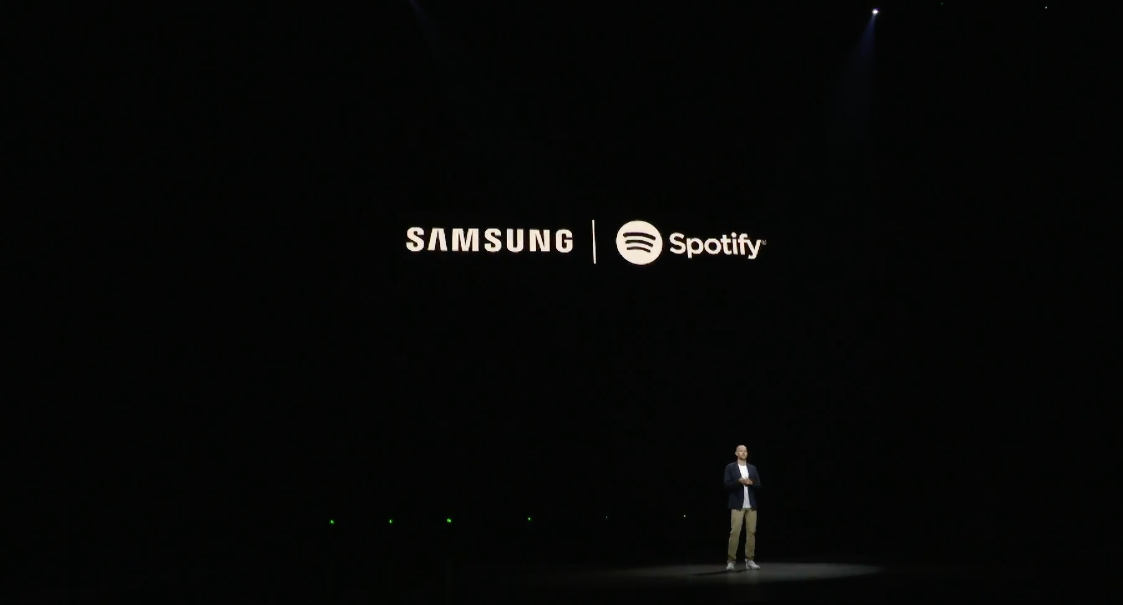
To go along with its new smart speaker, Samsung announced a partnership with Spotify, cementing the Swedish streaming service as the preferred music supplier on Samsung devices. Spotify will now be part of the set-up process for Samsung devices, and the integration allows for a seamless cross-devices listening experience within the Samsung ecosystem. The partnership also pins Samsung directly up against Apple and the HomePod’s exclusive integration with Apple Music.
7. Fortnite for Android launches as a Samsung exclusive
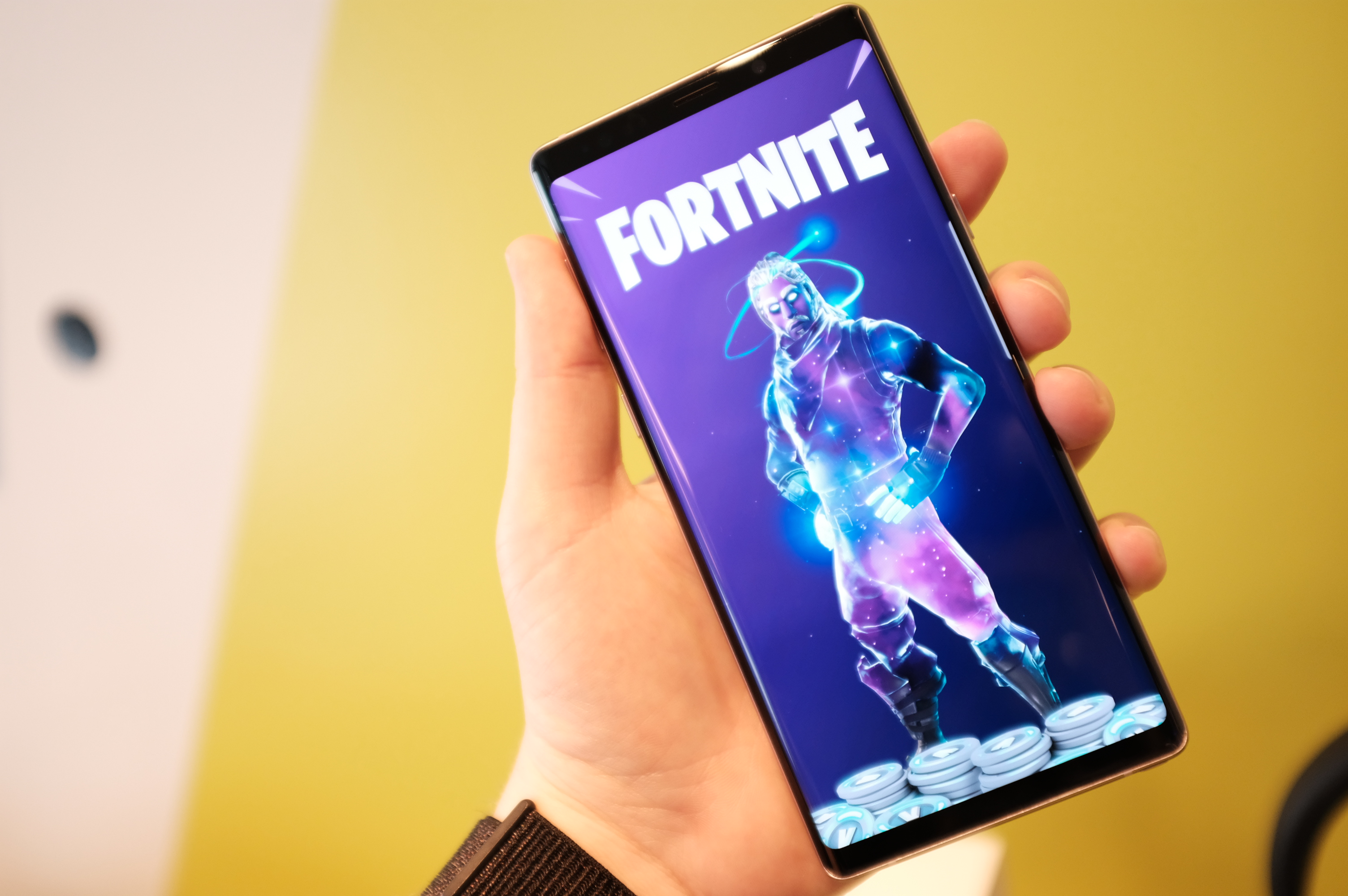
At long last, Fortnite is coming to Android this summer. The insanely popular survival game will be available for Galaxy users with an S7 or higher, and the 6.4-inch display on the Note 9 makes for a mobile gaming powerhouse. Starting today, the title will appear on Galaxy devices’ game launcher and will remain a Samsung exclusive until the 12th — at which point it will most likely be available to all Android users.
Powered by WPeMatico
Lyvly, a London-based startup that offers what might best be described as a members-based shared living and rental service, has raised $4.6 million in Series A funding. Leading the round is Mosaic Ventures, while Greg Marsh, who co-founded Onefinestay, has joined the burgeoning company as chairman and investor.
The latest take on how to improve the experience for “generation rent” in sprawling cities like London, Lyvly is at its most basic a two-sided marketplace that helps renters find high-quality shared living accommodations and landlords find good tenants. However, it goes far beyond simply matching supply and demand for house shares.
Not only are properties fully managed — including providing tenant services such as managing household bills, replacing consumables and cleaning — but at the heart of it all is the Lyvly community platform, which treats Lyvly renters as members within a network of “like-minded individuals who share a passion for shared living.” And, as wishy-washy as that sounds, there is no doubt that city living is often devoid of community, and in London especially it can be difficult to meet new people.
“Renting is often not a pleasant experience, and living in cities can be lonely and stressful,” says co-founder and CEO Philip Laney. “Moving into your new apartment, sorting out furniture and utilities, and then trying to connect with busy people around you all whilst working long hours in a transient economy are frustrations many of us have experienced. We are confronting three problems for renters in the city: their desire for community, convenience and affordability.”
Laney says the current way people rent shared accommodations is also painful for landlords, who don’t have consistency and control over the quality of their tenants, and often pay high fees to a middle-person and struggle with vacancy rates. “We provide them guaranteed income with no voids and no fees, and a genuinely positive social impact,” he says.

For renters, Lyvly operates a little like a members club. Once you’ve applied to join the community, you have a call with a member of the Lyvly team to learn more about your “life stage and values.” “We are people, not property first. So we establish what you’re seeking from your Lyvly move and whether you are keen to actively participate in the Lyvly community and share your life, not just spaces,” says Laney.
Next, you are given profiles of the members (and prospective housemates) you will be meeting with, and they are sent your profile and an overview as to why you are well-matched. You then meet each other, and if you like each other, you can apply online to the membership committee, which is made up of the most active Lyvly members and the team. This includes submitting your bio and stating why you want to be part of Lyvly, and what you would bring to the community.
Adds Laney: “Once you’re in, we then guide you through the whole moving process, taking care of everything and removing any usual stresses that come from moving to a new place in London. You are introduced to other members in the area who have similar interests and values and other members reach out to you directly to invite you to other activities they’re hosting. We also regularly host events and actively support members to engage with each other and give value to the community.”
Lyvly’s target tenants are 25-35-year-olds who are looking for single occupancy. Laney says that’s because they are at similar life stages to each other and this is where the startup can make a meaningful difference. “We really care about being something to someone, rather than everything to no one. In time however, we will be able to expand Lyvly into different community groups,” he says.
Landlords using the platform range from individuals who are first-time owners to some of London’s biggest property companies.
Asked who Lyvly competes with, he cites the grey and black economy of shared housing and “dodgy landlords.” Technically the company is also competing with estate agents, although it is open to working with them to help find better tenants for their landlords.
Meanwhile, don’t confuse the startup for co-living, build-to-rent developers who “put property first” and aim to profit from the development of assets. In contrast, Lyvly makes money from the managed services it provides and is not developing new property but renting out existing housing stock.
“We believe people like living in existing houses and apartments and what we need to do is create a community around that. It’s not the configuration of the spaces that need changing, but how people interact inside and outside of them,” says Laney, adding that the use of existing housing infrastructure also means that Lyvly is potentially a lot more scalable.
Along with Laney, the startup’s other co-founders are Dario Favoino and Siraj Khaliq. Both Laney and Favoino have a 10-year background in real estate investment and property management at Deutsche Bank and Realstar. And in case you aren’t keeping up, Khaliq is a partner at London VC firm Atomico and was previously CTO and co-founder of Silicon Valley startup Climate Corporation, which exited in 2013 for more than $1.1 billion.
Powered by WPeMatico